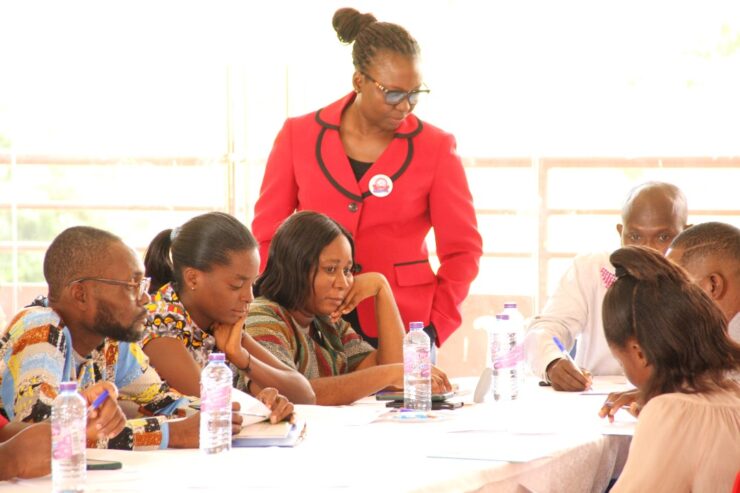What barriers to school leadership roles do women in Ghana face?
Helping women attain leadership positions helps children, too

Sonakshi Sharma of UNICEF Innocenti and Dewi Susanti of Global School Leaders led a team examining the career paths of school leaders in Ghana. They conducted a nationally representative phone survey of school leaders from 675 primary schools, as well as in-depth interviews with school principals, district leaders, teachers, and parents in 18 schools. Sonakshi and Dewi tell Hinah Mian about the obstacles women encounter, potential solutions to close gender gaps, and the ultimate impact on children.
Hinah Mian: In Ghana, women make up just 22% of teachers, 15% of principals, and 8% of school supervisors. Why is it important to increase the number of women in these positions?
Sonakshi Sharma: School leaders influence the school environment through promoting better pedagogy and through interactions with students, teachers, parents, and the community. Effective school leadership and management improve education outcomes for children.
“It is important to have a gender-equitable workforce that represents the population of the country.”
Sonakshi Sharma
It is important to have a gender-equitable workforce that represents the population of the country because it allows the education system – including children – to benefit from the perspectives, experiences, and leadership styles of both men and women.
Furthermore, women are competent school leaders. After controlling for contextual factors, we found in Ghana that schools led by women performed better than those led by men.
Dewi Susanti: In our recent evidence review, we found that women school leaders are more likely to exhibit a collaborative, collegial and instructional leadership style. There is also evidence that women leaders engage parents more in discussions, provide a more targeted approach to addressing challenges, and tend to have more nurturing people-management skills. Women have also been shown to be more concerned than men with creating a school culture that provides social and emotional support.
“Women school leaders are more likely to exhibit a collaborative, collegial and instructional leadership style.”
Dewi Susanti
SS: Additionally, exposure to women’s leadership can help combat negative gender stereotypes. Women can serve as role models. Girls might aspire to those roles themselves, and parents might come to have different aspirations for their daughters. In some instances, women school leaders may take more active steps to protect girls from sexual or gender-based violence.
Good school leadership, provided by both men and women, is important, and it is one of the most significant factors influencing student learning. We focus on women because they’re underrepresented and obviously face some barriers.
HM: What does your research tell us about why there are few women in school leadership roles?
DS: In Ghana, women remain underrepresented as teachers and as school leaders in primary schools and higher. This isn’t unique to Ghana. Across several countries in Sub-Saharan Africa, the same trend holds. Even in places where most teachers are women, very few of them make it into leadership roles. In countries like Niger, Zambia, and Burkina Faso, for example, there’s a gap of more than 30 percentage points between women’s representation in teaching and in school leadership.
SS: Cultural norms and women’s home responsibilities pose a significant barrier for teachers and school leaders. The societal expectation that a woman’s domain is the home can dissuade women from entering the profession or prevent them from being selected for school positions; there is a perception that they might not be able to give such a career their all.
“Cultural norms and women’s home responsibilities pose a significant barrier for teachers and school leaders.”
Sonakshi Sharma
Moreover, Ghanaian teachers are aware of the stress and amount of work involved in taking up a leadership position. There is a big increase in responsibility relative to a teaching position, but not necessarily a proportionate increase in compensation, and training is limited. As women typically shoulder greater household responsibilities, the additional workload disproportionately affects them. These factors may lead women to forgo taking that next step to pursue leadership roles.
Another barrier is money. Women teachers don’t always have the resources to attain a master’s degree, which is highly valued by certain districts and makes women feel more competitive in the job market. The cost of further education competes with resources they need for their children and their households.
DS: While more female than male leaders have a master’s degree, it tends to take women longer to become school leaders, possibly because of the time they take off to raise children. Many women are also concerned about being placed in rural rather than urban areas, a concern that may lead them to question whether teaching is the right career choice for them.
“While more female than male leaders have a master’s degree, it tends to take women longer to become school leaders.”
Dewi Susanti
SS: District directors generally believe men and women are equally qualified for leadership roles. However, they consider gender when assigning head teachers – taking into account things like accommodation and transport, especially when schools are located in rural or more remote areas and can only be reached by motorbike. They believe that many women would not accept positions in those schools and that it might be difficult to retain those who do. Women themselves agree with their concerns.
HM: Did any insights from your survey of school leaders surprise you?
DS: We had thought that women might face more challenges than men after becoming school leaders. Overall, however, female and male head teachers are confronted with similar challenges. The most difficult challenge for all school leaders is managing their schools’ financial affairs and infrastructure. Male head teachers reported being more stressed about teacher and student attrition and about physical safety and security, probably because they are more likely than women to be working in rural areas.
SS: We tried to assess bias in how women and men are perceived as school leaders by asking about qualities like being approachable, assertive, and collaborative. Women rated women more highly than men across all such traits, and men rated men more highly across all traits with the exception of being kind, organized and communicative. This is relevant, as there are more men than women in the education system, particularly in district-level supervisory or decision-making positions. On a positive note, however, both men and women across different types of stakeholders felt that available opportunities for both genders were relatively equal.
HM: Based on your findings and discussions with the Ministry of Education in Ghana, what solutions might close the gender gap in school leadership?
DS: Ghana’s education ecosystem generally provides equal opportunities for both men and women to attain leadership roles. However, women face additional barriers rooted in their role in society. Additional encouragement from the government could make a difference; for example, the government might offer mentorships for women. Women who have become school leaders have often received support from a mentor already in the system, as well as strong support from their families.
“Seeing more women in leadership roles can help influence traditional norms, kickstarting a virtuous cycle.”
Sonakshi Sharma
SS: Training for men and women head teachers could help and might especially benefit women, particularly by boosting their confidence. Well-designed incentives, financial or other, can help attract and retain women in rural schools. Other long-term solutions include improving facilities and providing infrastructure in rural and remote areas. Almost 70% of schools in the country are in rural areas. If women cannot stay in rural schools due to poor infrastructure, poor transport services and longer commutes, then there will never be women teachers to move on to leadership positions. Targeting norms and perceptions around gender can be a longer-term process, but it is possible to work with children to change the younger generation’s perceptions of appropriate roles for women. Seeing more women in leadership roles can help influence traditional norms, kickstarting a virtuous cycle.
We are hoping to work with our Ministry counterparts to co-create more concrete and short-term solutions within the current context. We hope that together we will be able to increase women’s representation in leadership positions, ultimately improving children’s learning and providing role models for girls.
Footnotes
Sonakshi Sharma is an Education Research Specialist at UNICEF Innocenti, where she collaborates with UNICEF Country Offices and Ministries of Education across Africa and Asia to implement research and strengthen technical capacity. She currently leads two research portfolios, on teacher allocation and women school leaders. Sonakshi has experience generating evidence and leading impact evaluations across the education, health, and agriculture sectors.
Dewi Susanti leads an effort to generate effective professional development and policy content for school leaders in the Global South. She joined Global School Leaders (GSL) as Senior Director of Research after over 20 years of experience in improving education equity and quality, split equally between program development and research. She led the GSL research agenda, which aims to understand the impact of school leadership training programs in improving teaching practices and student outcomes and the role of the education ecosystem in supporting school leaders.
Together with their team, Dewi and Sonakshi have developed a research toolkit for gaining a better understanding of why underrepresentation exists in other contexts which face similar challenges. The toolkit will be published later this year.
This interview has been edited for clarity.


